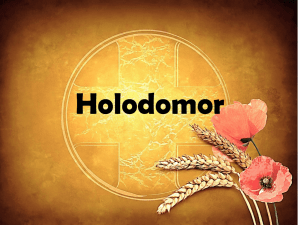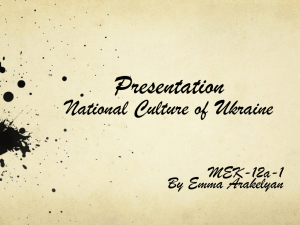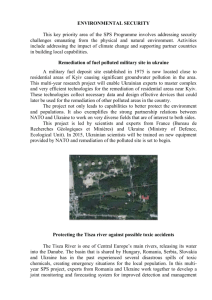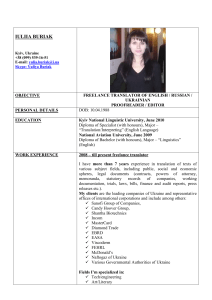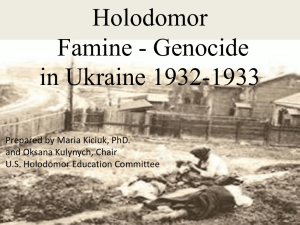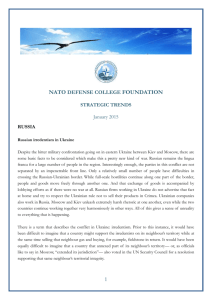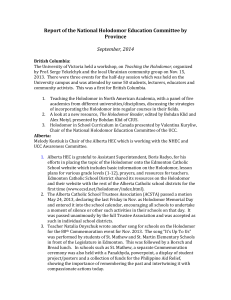Secondary - A Holodomor Survivor`s Story
advertisement
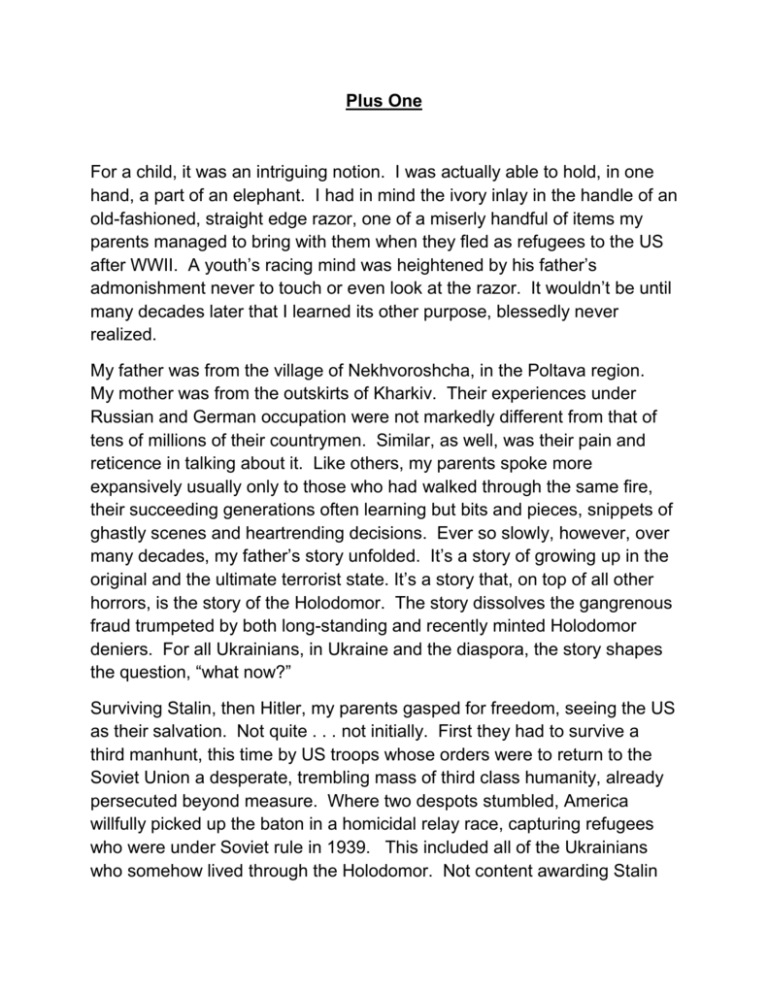
Plus One For a child, it was an intriguing notion. I was actually able to hold, in one hand, a part of an elephant. I had in mind the ivory inlay in the handle of an old-fashioned, straight edge razor, one of a miserly handful of items my parents managed to bring with them when they fled as refugees to the US after WWII. A youth’s racing mind was heightened by his father’s admonishment never to touch or even look at the razor. It wouldn’t be until many decades later that I learned its other purpose, blessedly never realized. My father was from the village of Nekhvoroshcha, in the Poltava region. My mother was from the outskirts of Kharkiv. Their experiences under Russian and German occupation were not markedly different from that of tens of millions of their countrymen. Similar, as well, was their pain and reticence in talking about it. Like others, my parents spoke more expansively usually only to those who had walked through the same fire, their succeeding generations often learning but bits and pieces, snippets of ghastly scenes and heartrending decisions. Ever so slowly, however, over many decades, my father’s story unfolded. It’s a story of growing up in the original and the ultimate terrorist state. It’s a story that, on top of all other horrors, is the story of the Holodomor. The story dissolves the gangrenous fraud trumpeted by both long-standing and recently minted Holodomor deniers. For all Ukrainians, in Ukraine and the diaspora, the story shapes the question, “what now?” Surviving Stalin, then Hitler, my parents gasped for freedom, seeing the US as their salvation. Not quite . . . not initially. First they had to survive a third manhunt, this time by US troops whose orders were to return to the Soviet Union a desperate, trembling mass of third class humanity, already persecuted beyond measure. Where two despots stumbled, America willfully picked up the baton in a homicidal relay race, capturing refugees who were under Soviet rule in 1939. This included all of the Ukrainians who somehow lived through the Holodomor. Not content awarding Stalin with diplomatic recognition of his legitimacy during the Holodomor, the US now provided a bonus by rounding up the Holodomor’s remnants. The January 4, 1946 order of Headquarters, US Armed Forces, European Theatre, was clear: “by force if necessary.” Suicides exploded in the DP camps. With a friend, “Slavko”, my father located a barely functional motorcycle (he considered it a trifling down payment for his previous slave labor in Germany), and raced through Bavaria removing road signs, determined to do what they could to stymie roving squads of American GI’s and their NKVD handlers. My father swore never to be taken alive, whether by American GI’s or Russian NKVD. For him the ivory inlaid razor would be the final escape. He carried it, hidden, wherever he could during his several years in Germany. He finally openly placed it with their belongings as my parents boarded a ship bound for America. He never touched the razor again. In a departure from his usual reticence to talk, my father once described how his father, my grandfather, was arrested and imprisoned in the village jail, then shipped to the infamous Lubianka prison in Moscow. He never returned. His father and uncle had fought against the invading Red Army years earlier. As the village postman, my grandfather’s name eventually surfaced on the hit list. Crawling up at night to the outside jail window where he believed his father was being held, my father instead heard the screams of another “enemy of the people” as her hands were placed in a cauldron of boiling water until her skin sloughed off. “Taking off the gloves” was a favorite pastime of Putin’s heros. Nastia Ivanovna had been my father’s elementary school teacher, arrested for “fomenting animosity along national lines” – she had insisted on speaking Ukrainian with her students. Massive infection snuffed out her life. A conveniently generic malady for her death certificate. As he aged into his 80’s and 90’s, my father’s past increasingly tormented him. With less and less respite, and with more and more viciousness. At night, at home and in the hospital, he would scream, sometimes calling out for his own mother and father, sometimes crying, but never himself waking from the nightmares. Once, as my father was being transported to his hospital room, he began trembling so hard that the gurney shook. The nurse and transport aids were perplexed. He was warmly covered. His eyes however were darting back and forth in fear. He whispered to me, “Run home and get some money. They’re taking me to be tortured. [“Berut’ mene kaznyty.’] I have to buy them off.” At another time, the hospital tried to accommodate his weak English ability by assigning a Russian-speaking (what’s the difference, right?) nurse, aide or doctor. Upon hearing Russian, my father would start shaking again, staring straight ahead without responding. It took my usual explanation to the hospital staff about Russia vs. Ukraine before they saw the light. On the Tuesday to Wednesday night before Thanksgiving last year, my father relived the scene he witnessed as his family home was surrounded by the NKVD, subsequently arresting his father. For hours on end, he stumbled on crutches from window to window in our home, peeking through the blinds, seeing ghosts that were not ghosts. In the middle of the night he fled the house. He escaped. We found him early Wednesday morning lying outside in a puddle, soaking in an icy November rain unable to rise. But it was the Holodomor that persecuted him the most relentlessly, more than the encounters with the NKVD, more than the near death escapes from the German SS, more than his labors as an ostarbeiter in Germany, more than staying ahead of the unholy alliance between American soldiers and Soviet secret police. Initially, it was benign . . . relatively. Since childhood I remember so clearly how, whenever asked if he was hungry, or on his own volition, he would simply ask, “A chy je kusok khliba?” [Is there a piece of bread?]. That’s it. Just bread. Nothing more. Ever. Not after an Easter or Christmas dinner, not after a Thanksgiving dinner. Slowly, inexorably, the monsters breached the barricades. I overheard my father describe one scene to a family friend. He was a 16 year old teenager at the time and, with his two older brothers, peeking through the ladder braced against the edge of the loft that was their bedroom. They watched a neighbor stumble into their house late one night, carrying a burlap bag with what appeared could have been a head of cabbage. The neighbor placed the bag on the floor, bracing it against the wall and bench. Slowly, the bag drooped. The head of a human being rolled out, instead. A land where every other person seemed to want to compete to become either a concert soloist or a poet, overnight became the land of the walking dead. Kidnapping became a food source. Now, it was Spring, 1933, and the Holodomor was raging full tilt. The neighbor’s meal was already a corpse, lying but a few dozen feet from my father’s home. It was dismembered by fleeting shadows, which would descend from nowhere and disappear as mysteriously. The neighbor considered himself fortunate, and soon left with his trophy. He starved to death two weeks later, nevertheless. Two months after his hospitalization following the Thanksgiving “escape”, I served my father a spaghetti dinner with meat sauce. He sat motionless, eyes welling up. “What’s wrong?” I asked. He had spaghetti many times before and liked it. This time, almost inaudibly, he asked, “Why did you give me human meat to eat?” What did my father say, what would he have said, about the community’s campaign to overcome world disbelief, and sometimes the derision and scorn, concerning the Holodomor? We’ve heard it all before: “It really didn’t happen. It really wasn’t that bad. It really happened, and it was really bad, but it happened to everyone. It really was not intentional. It was – inexplicably somehow – a “mistake”. A realpolitik necessity to earn foreign currency to finance industrialization, etc, etc.” How does my father’s life experience, a proxy for the lives of so many millions, inform for us the issues today? What did he say, what would he say, about the genocide “debate” and what he called the “numbers game” engendered around the Holodomor? For him, the entire period of Russian rule of Ukraine was one, apocalyptic war crime. Past atrocities can be extrapolated and the future was openly predicted in 1870 by Russian Minister of Education DmitryTolstoy: “The ultimate goal in the education of the non-Russians must be their Russification and assimilation within the Russian nation.” Shortly afterward, Fyodor Dostoyevsky, wrote: “All people should become Russian and Russian above all else, because the Russian national idea is universal.” It was a war. Many decades later, Pavel Sudoplatov would so declare it. Who was Sudoplatov? He was a key figure in the Soviet secret police, first the Cheka, then renamed the OGPU, GPU, NKVD, KGB and now the FSB. He was, in the Ted Turner’s words to NBC’s Tom Brokaw, a member of “an honorable profession.” Sudoplatov was in charge of the Soviet penetration of Manhattan project , convincing Robert Oppenheimer and Enrico Fermi to relay secrets of American’s atom bomb project to Moscow. But Sudoplatov’s pre-eminence was as a master of “wet deeds,” an assassin that only Putin can emulate. Having organized the assassination of Leon Trotsky in Mexico, Sudoplatov turned to the assassination of Ukrainian leaders, in Ukraine and abroad, in what he described as Russia’s “75 year war” against Ukraine. He wrote in his memoirs that the war ostensibly ended only when Ukraine declared independence and was so recognized by the world. In that war, in 1932-33, Soviet Commissar of Foreign Affairs Maxim Litvinov summarized it all, “food is a weapon,” the ultimate weapon of mass destruction. For my father, therefore, the Holodomor went beyond “mere” genocide, it was an indescribable phenomenon wrapped within one, massive ongoing war crime. He considered UN Genocide Convention originator Rafael Lemkin’s characterization of the Holodomor as genocide to be an understatement and therefore incomplete. And that was simply because no accurate characterization for the Holodomor has yet been conceived other than the diluted notion of “genocide.” In number of victims and destruction of a nation’s fiber, psychology, sense of self, in terms of coming to the precipice of destroying a nation, in terms of its effects carrying through and being so manifest 80 years afterward, the Holodomor is without parallel in human history. My father would challenge the notion, in some quarters, that somehow it is wrong to compare genocides. Why, exactly? Without comparison, he would say, there can be no learning. Whether in Armenia, Kosovo or Cambodia, the massacre of innocents was a horrific aberration from the normal course of nation building or day to day existence. But it was an aberration. Those genocides did not lead a people to the brink of extinction as a nationally conscious body with the effect that is seen today in Ukraine. Those peoples , today, know who they are. Hitler’s attempted destruction of, among others, European Jews comes to mind. But then, my father believed that any parallel between the Holocaust and the Holodomor was off-base. They were different. The Holocaust, being the 13 years of Nazi rule and its campaign against the Jews, would have to be compared instead, not to the Holodomor, but to the corresponding 70+ years of Soviet Russian rule and its campaign against Ukrainians. During that period, the Holodomor was but one mechanism in Sudoplatov’s war against Ukrainians, as was one of Hitler’s mechanism in his destruction of the Jews, be it firing squads or gas chambers. The Holocaust was not just one of those mechanisms, but the totality of the effort. The Holodomor was not the totality, but just one of the mechanisms. The Holocaust was the whole story. The Holodomor was only one chapter. More fundamentally, whereas the Holocaust became the unintended catalyst behind the founding of the Israeli state and the crucible – and guarantor – of the modern Jewish identity, the Holodomor achieved its intended effect of causing the very opposite in Ukraine – “a smashing success,” gloated Stanislav Kossior, a member of the Politburo and one of Stalin’s deputies in Ukraine. The Holodomor, raging for approximately nine months, interred the idea of Ukrainian independence for generations. It was so effective that after lifting it in late Spring of 1933 Stalin felt sufficiently secure to transfer the temporary Soviet capital from Kharkiv to Ukraine’s historic capital, Kyiv. The Holodomor caused the catatonic cripples roaming Ukraine today. So much so that, though Ukraine is today nominally independent, it is, at bottom, not a Ukrainian state. Never in one sitting but during the course of many decades my father would mourn over the questions: What happens when for more than half a century you’re required to march in parades joyfully worshipping the murderers of your family, when you are required to believe that your family deserved to be killed, or that they weren’t really killed but simply somehow disappeared, when you cannot grieve because you shouldn’t grieve because there’s nothing to grieve for, when you fear to whisper a word to your children and grandchildren, when you’re instead required to mouth a miasma of lies and to convince your children and grandchildren of the truth in the executioner’s denials? What happens when there is no acknowledgement, no apology, no contrition, no punishment? Of anyone? Ever. Reparations? You are deformed to represent the quintessential Stockholm Syndrome, the victim identifying with his tormentor. You become a nation that condemns those who condemn its own executioners, you deny your own tragedy as a victim, you castigate those who seek to identify your family’s gravesites, and instead you grieve, as being unjustly accused, for those who disemboweled your own being. Would in Israel today, at any time, anyone even conceive of a statute of Hitler, a hospital named after Mengle, a children’s playground named after Eichmann, Goebbels or Goering? You get the idea. And the monumental difference between the Holodomor and the Holocaust. My father would slowly rock his head in disbelief, as almost to pity the Holodomor deniers. He would summarize one of their versions: “It was simply the unfortunate but nevertheless unintended consequence of overly zealous true believers in an exuberant frolic toward a brave new world.” The Holodomor was thus, fundamentally, a question of intent. In any court, in any country, by any standard, at any time, the issue of “intent” in the organization and implementation of the Holodomor is beyond any question, beyond any doubt. Hardly a scholar himself, my father would recite events that would put any sputtering academic on his heels. What are the proofs ? First. Lenin famously said, “without Ukraine we [Russia] will lose our head.” With Russian rule of Ukraine perceived by Moscow as still dangerously tenuous, on the eve of the Holodomor, August 11, 1932, Stalin wrote to his satrap in Ukraine, Lazar Moiseyovich Kaganovich. (This was only four days after his decree, described below, concerning the “theft” of socialist property.) Raising the alarm over Ukrainian resistance to Russia’s rule, Stalin wrote, “Things in Ukraine are terrible . . . . If we don’t make an effort now to improve the situation in Ukraine, we may lose Ukraine ….” He ordered Kaganovich to “transform Ukraine into truly a fortress of the USSR . . . . Without these and similar measures . . . I repeat – we can lose Ukraine”. Already in 1930, Stalin’s deputy, Stanislav Kossior addressed a meeting of Communist Party activists in Ukraine: “We will show him [the Ukrainian villager] what famine is.” Petro Grigorenko, a young Ukrainian Communist Party activist at the time, eventually became a world renowned human rights activist in the Soviet Union and emigrated to the U.S. He was one of the plenipotentiaries of the Central Committee of the Communist Party and was in the audience addressed by Kossior in 1930. In his memoirs, Grigorenko wrote: “I saw the awful danger that hovered over our people,” reciting Kossior’s threat. My father recounted the ad nauseum denunciations in the press of “Petliurites,” “nationalists,” “bourgeois nationalists,” “nationalist deviationists”. Three years after threatening famine, and with the Holodomor raging, Kossior wrote to Stalin in March 15, 1933, “that famine still hasn’t taught reason.” Later, however, with the countryside totally prostrated, Kossior prided himself: “Acknowledging the great amount of work put . . . into the fight against Ukrainian nationalist and other counterrevolutionary elements, work which has not ceased and which shall not cease, we must say that of course we gave the nationalists a beating, a good one, and as the saying goes, we had a smashing success. . . .” Another Stalin sycophant, Pavel Postyshev said in 1934: “We have annihilated the nationalist counter-revolution during the past year, we have exposed and destroyed nationalist deviationism. . . .” Chervonyj Shliakh [The Red Path] in Kharkiv wrote: “1933 was the year of the overthrow of the Ukrainian nationalist counterrevolution” and in that year the Party had conducted the “Herculean labor of liquidating nationalist elements in Ukraine.” The Second Secretary of the Communist Party of Ukraine [not the “Ukrainian Communist Party”], Mendel Khataevich wrote, “It took a famine to show them who is master here . . . . We have won the war.” The degree of Stalin’s micromanagement of the homicide campaign was illustrated by a December 14, 1932 decree of the Central Committee of the Communist Party of the Soviet Union and the USSR Council of People’s Commissars, individually signed by Stalin and Molotov, where officials at the local, county (raion) level were singled out by name for arrest for “harboring anti-Soviet Ukrainian nationalist conspiracies” and the term of their sentences fixed. Second. Against the above background, the glaring anomaly snaps into focus. One of the richest food source countries in the world abruptly loses millions of its farmers (of all people) to starvation, with no reason attributable to weather, pestilence or other natural calamity. Ukraine, after all, was not some barren, rocky atoll in the Pacific. Without an outside cause, millions of a nation’s food growers, being at nutrition’s very point of origin, do not simply starve to death, overnight. Valentin Berezhkov was Stalin’s personal interpreter at his talks with Churchill and Roosevelt, and previous to that personal interpreter for Vyacheslav Molotov, the “People’s Commissar for Foreign Affairs” during the negotiation with Hitler leading to the infamous Ribbentrop/Molotov pact in 1939. Berezhkov spent many years in Ukraine, and wrote about his experience during the Holodomor in his memoirs: “In the past, the word combination that is the title of this chapter [“Famine in the Ukraine”] would have been taken as a contradiction in terms. A fabulously rich country with fertile lands, vast natural resources, and a hardworking people . . . and suddenly – famine! In time of peace, too!” The only thing Berezhkov got wrong was that it was a time of war, not peace. Third. My father made the obvious point that you’d sooner expect the cities to starve, not the countryside that produced that very food. Though there was starvation in the cities, with its predominantly Russian and Jewish populations, it was the countryside that was overwhelmingly Ukrainian and that’s where the massive exterminations were directed. Food was not removed from the cities. It was removed from the countryside. Ukrainian villagers were barred from the cities, and any food aid for them was also outlawed. Fourth. Many Holodomor deniers often no longer deny a famine, but prefer to simply homogenize the Holodomor. They like to point to hunger and malnourishment in other parts of the Soviet Union at the time. But no one was rushing into Ukraine to escape privation elsewhere in the Soviet Union. Ukrainians were fleeing Ukraine, or trying to, but were prohibited from doing so. The border was sealed. Foodstuffs carried by persons travelling into Ukraine were confiscated before crossing. Tellingly, it was a blockade also of the historic and heavily Ukrainian Kuban and North Caucasus regions of now Russia. We have Stalin’s express order on that one. Nowhere else was there a blockade. Not surprisingly, the line of demarcation was stark. Ukrainian villages starved. A few kilometers across the border, Russian villages did not. Kazakhstan is sometimes raised as another Soviet republic that suffered famine, in a specious parallel to Ukraine. But neither Kazakhstan nor any other republic or region, least of all Russia itself, was blockaded. One-half million Kazakhs freely left for other parts of Soviet Central Asia, and another 1.5 million managed to make it to China. Furthermore, there is a world of difference between hunger and starvation, and between starving and being starved to death. If, for sake of argument, elsewhere in the Soviet Union other nations had in fact been actively and intentionally “starved to death”, if any of the measures undertaken against Ukrainians had in fact been undertaken against other specific nations, then it would make the genocide, if we wish to call it that, all that more horrific. It would be preposterous to argue that Nazi extermination of millions of Ukrainians, Poles and other peoples changes the fact of Nazi extermination of Jews. On January 17, 2007, V.P. Kozlov and V.V. Kondrashyn of the Federal Archival Agency (RossArkhiv) at the Russian Ministry of Culture and Mass Communications issued the marching orders to Russian academics. Firstly, the conceptual framework was cast as conveniently generic, allUnion “enforced collectivization and industrialization”. Secondly, academics were ordered to conform documents to the framework, with the purpose of suppressing anything that would demonstrate the unique situation in Ukraine. Had I mentioned this to my father, he would have simply nodded his head, as if to say, “So what else is new?” True to form, Viktor Yanukovych, the President of Ukraine [!], dutifully intoned to the Parliamentary Assembly of the Council of Europe, “We consider it incorrect and unjust to consider the Holodomor a fact of genocide of a certain people," calling it "a common tragedy" of everyone in the Soviet Union. (I’m reminded of Marquis de Custine’s observations after his visit, in 1839, to the Empire of the Czar (the title also of his book). Among his observations was, “Russian despotism not only pays little respect to ideas and sentiments, it will also deny facts; it will struggle against evidence, and triumph in the struggle!”) And finally . . . in the early 1950’s, the Harvard University conducted in Munich and New York the first significant Soviet refugee study. So repetitive and consistent (and hair-raising) were the accounts of the Ukrainian remnants of the Holodomor that the interviewer would periodically turn off the recorder due to, simply, redundancy. What other nationality paralleled those accounts? None. Certainly the Russians have never pointed to anything remotely similar to the Holodomor in their experience in 1932-33. Nor have other nationalities of the Soviet Union commemorated such a tragedy in their communities, worldwide, during the many decades since those events. Given the detail and consistency of the accounts, Moscow may yet argue, with the most somber affectation of intellectual rigor, that the refugees had developed a uniquely Ukrainian precursor to Facebook. Fifth. Holodomor deniers often spin the story, contending that excessive grain procurements, though perhaps “unfortunate”, were necessary to finance industrialization. (a) On that logic, Hitler would be excused for his extermination of the Jews if he could make an economic connection to construction of the autobahn. (b) Industrialization for whose benefit? (c) Non-grain producing regions of Ukraine, e.g. Vinnytsia, were cleansed of Ukrainians as thoroughly as grain producing regions. (c) My father and others who lived through the Holodomor hardly ever mentioned “excessive grain procurements,” but spoke in stark detail of the focused, frenetic campaign by “party activists” to deprive the Ukrainian villages of anything even remotely edible. Party activists and GPU personnel were issued steel pikes with which to probe the ground and rip open floor boards, searching for a rotting cabbage leaf or crust of bread. Farm buildings were demolished in the search. Human excrement was minutely examined to determine a possible food source until even that stopped; there wasn’t enough for the human body to process. Those not obviously starving were immediately suspect, and interrogated mercilessly. My father recounted one party activist, a monster of a man, gleefully picking up an emaciated child by the ankle and holding it upside down, shaking it like a rag doll until the child spat out a mouthful of watery “soup” made from crushed worms and weeds. In another scene, my father was, unbeknownst to him, the subject of Stalin’s January 1, 1933, order to Kossior, then a member of the Politburo and secretary of the Communist Party of Ukraine. The order established a macabre protocol for denying Ukrainian villagers access to forage grain intended for horses (those that still survived) to be used in the Spring sowing in 1933. The feeding was to be done in the presence of three witnesses, including at least one party functionary, all to be written down and signed. “Merciless persecution” was prescribed for the triumvirate that would allow humans access to the grain. My father was one of the famished, chased away at gunpoint. Where did the animal forage come from if there wasn’t anything for humans to eat? Sixth. Farming implements were confiscated. Harnesses, millstones, plows, shovels, rakes. Cooking utensils, bowls, pots, spoons and forks, were confiscated as well. Why not simply broken? Because they could be repaired. Stoves, which also served as the only heat source for village homes in minus 30 degree weather, were too massive to be removed, so they were systematically destroyed, the bricks pulverized to prevent rebuilding. Seventh. My father recited the methodical removal under GPU guard and at night of seed grain from his and neighboring villages. It was shipped to the cities and towns, and stored under guard in massive silos built for that purpose. Why was the seed grain removed? For fear that the soon the very farmers who grew the grain would devour it, eliminating the possibility of next year’s crop. But why would those who are pre-eminent in agriculture commit collective suicide devouring grain destined for future seeding? Furthermore, if avoiding certain death now by eating the seed grain was preferable to future death months later, why would people risk certain death now in the face of Stalin’s August 7, 1932 decree declaring all foodstuffs and other property as belonging to the state? The death penalty was the sanction, with children shot as readily as adults. Because soon there would be nothing else to eat. And how would anyone know that? You get the point. Eighth. My father spoke of vast fields of grain, never harvested, and guarded day and night, smoldering until it rotted into the ground. Warning shots were rare. Endlessly squirming but always predictably relentless, Holodomor deniers argue that lack of machinery and an antiquated transportation system prevented timely harvesting and removal. They are not fazed that this argument is irreconcilable with their simultaneous and opposite argument of excessive grain procurements for export . Windows on trains passing through the Ukrainian countryside were sealed to prevent passengers from throwing out food scraps to starving villagers who lined the tracks as the trains sped by, starving villagers having earlier been barred from approaching the train stations. No response to that one by the deniers. As to the “numbers game” my father would say it’s driven by the same imbecility, or worse, that argues that Stalin perhaps didn’t know about what was going on and it all sort of “just happened. “ He would repeat, more than once, that Stalin knew what was in your own mind even before you did. During the Nazi occupation, my father was imprisoned by the German SS in Kharkiv, but escaped and made his way back to Poltava, barefoot (the Germans removed his shoes in prison). In the course of meandering the 100 or so miles, he saw the Holodomor’s devastation of the countryside 10 years earlier. Between the two cities was the richest stretch of agricultural bounty in one of the richest lands in the world, summarily depopulated of easily a third its native population during the Holodomor. Then, the entire population of every fifth village had been exterminated. That’s 20% of the rural population. In the remaining four villages no more than a half of its inhabitants somehow survived, many with no more than ten or twenty percent. During his trek, my father made the calculus simply by meeting the occupants. Now, there were no longer Ukrainians, but virtually all Russians in the previously wholly decimated villages. And a pro-rata number in the other villages. To be sure, all of Ukraine had been overrun by the Nazis, and cities and countryside alike were destroyed and depopulated. Nonetheless, the outlines of a massive Russian repopulation of deserted Ukrainian villages were stark and screamingly obvious. The ultimate “ethnic cleansing”. If that is not to be believed, then we have the diplomatic dispatches of the Italian vice-counsel in Kharkiv at the time. Sergio Gradenigo wrote in his report, no. 74/106 of May 31, 1933 entitled “The Famine and the Ukrainian Question,” that the famine was instituted with the intention of “teaching the (Ukrainian) peasants a lesson.” Quoting a top officer of the GPU, it was for the purpose of “changing the ethnographic materials” because Ukrainians could not be changed-over into “worthy communists.” In other words, the Italian consul wrote, the government’s “goal was to liquidate the Ukrainian problem in the course of several months by sacrificing 10 or 15 million souls.” Gradenigo wrote that “‘. . . the current disaster will accomplish the colonization of Ukraine, mostly Russian. And that (colonization) will change Ukraine’s ethnographic character. Perhaps, in the very near future, it will not be possible to speak about Ukraine, or about the Ukrainian nation, and particularly about a Ukrainian question, because Ukraine will become, in fact, a Russian colony. ” Remember Tolstoy and Dostoevsky? My father did not know that a December 29, 1933, report by the All-Union Resettlement Committee of the Soviet of Peoples Commissars of the USSR to the head of the GULAG, Matvei Berman, detailed the resettlement of Russians to the “sparsely populated” areas of Ukraine. Most were retired Red Army officers, functionaries of the GPU and others whose loyalty was thus rewarded, and whose progeny are a fifth column in Ukraine today. The “resettlement” plans were put into place before the induced starvation in Ukraine. As with the removal of the seed grain, in advance, how did anyone know, in advance, that there were going to be “sparsely populated” areas in Ukraine? In fact there were no such areas. The entire Ukraine was reengineered to be “sparsely populated.” My father took a direct, no nonsense approach to the numbers. Taking into account the only Soviet-based statistic that he would consider to be even reasonably close to reality—the 1937 census whose statisticians were shot for “intentionally undercounting the population” -- and given the overwhelming preponderance of Ukrainians in the rural areas of Ukraine, my father viewed the 6-7 million as an absolute minimum. He damned the deniers who seamlessly became minimalists, “experts” who a day before had sniffed contemptuously about the very existence of any “holodomor”. For him, numbers made a difference. Isn’t the killer of 100 children worse than a killer of one? We know from British diplomatic dispatches that, starkly contradicting his denials in The New York Times, Walter Duranty had privately spoken of 10 million killed. Other diplomats reported the same approximate number, some even higher. And the late James Mace, the pioneer in bringing the Holodomor to the attention of the English speaking world, wrote that the frequency and levels at which the 10 million figure circulated among the Party elite is reason enough to believe that it was as accurate a death list as we will ever have. My father, Wasyl Sydorovych Rud’, died on May 2. Neither a mutilated life, nor a savaged soul, nor a broken heart is a bureaucratically recognized cause of death on his death certificate. I know that he was never a Holodomor survivor. There never were any. He never escaped Russia’s barbarity in Ukraine or its most fearsome tool, the Holodomor. It had been methodically, diabolically, digesting “survivors” since 1933. It stalked him to his last day. The question can be posed yet again, as it should have been raised following the passing of each of tens of millions of souls murdered by Moscow over the centuries: “What, now?” “What do we do?” Ukrainians know, too well, the mournful “Vichnaja Pamiat’” sung at our funerals and panakhydy. My father would say that “Eternal Memory” is not enough. It is an absolute pre-condition to everything else, a necessary first step. But standing alone, sterilized of action or behavior, now or later, mere memory is almost irrelevant. My father’s experiences were not only not unique, but rather measured by comparison with so many of his countrymen. He, and they, would all say that each Ukrainian, in his own, personal way, must overcome a virtual genetic predisposition toward passivity, that damning Ukrainian trait, “Nekhaj bude spokij” [“Let us simply have peace, quietude”]. Why, my father once asked me (or himself, perhaps), do we so diplomatically speak of millions of Ukrainians as having been killed, as having died, perished? They weren’t. They were murdered. They were exterminated. They were massacred. “Zbahny!” [“Get it straight!”] , he would say. He summed it up: The French had a revolution. The Americans fought a bitter war. The Russians murdered several score million people. The Rumanians used a bullet to the head. The Ukrainians? They sang songs. He would say that each of us must ponder the question, how could Israel’s president lecture Ukrainians to forget history? How well known, and how utterly distorted must be that specific twist—“nekhaj bude spokij”-- in the Ukrainian DNA for such a pronouncement to be made? My father would demand that we all be assertive of our history, of our truth. How can it be that a mass murderer is more aggressive, more energetic, more committed to hijacking your home and murdering your family than you, as the rightful homeowner, are in defending yourself and your family? It’s perverse. Don’t just mumble the truth. Scream it. Demand it. Categorical, unsparing intolerance is not just necessary. It’s obligatory. Intolerance of injustice, intolerance of evil, intolerance of falsehood. It’s that very kind of intolerance that is necessary to help counter the growing defeatism – in the diaspora and in Ukraine -- over the slingshot into the past and to which Putin’s minions have seemingly condemned Ukraine. Make the accusation. Again and again. And never, never give up How, practically speaking, these observations are to be implemented – or not – is a matter of the priorities, large and small, that each of us establishes and continuously reorders in our daily life. What and how do we instill in our children so that they don’t simply “know,” but so they also have within them the necessary inner catalyst to pass on to their own children and succeeding generations not just that same knowledge and memory but also that very same catalyst, from generation to generation? At its core, my father would quietly say that it is a matter of one’s own conscience, and overcoming the trifling, ridiculous inconveniences that a real world commitment would introduce into our personal lives. A heinous history came close to obliterating a nation of singers and poets. It has churned through generation after generation. But it also created a legacy of human opposition to the demonic that is noble and pristine. It created titans. Copy, print or delete. It’s our call.
